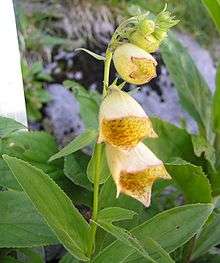Digitalis grandiflora
| Digitalis grandiflora | |
|---|---|
 | |
| Digitalis grandiflora at Schynige Platte | |
| Scientific classification | |
| Kingdom: | Plantae |
| (unranked): | Angiosperms |
| (unranked): | Eudicots |
| (unranked): | Asterids |
| Order: | Lamiales |
| Family: | Plantaginaceae |
| Genus: | Digitalis |
| Species: | D. grandiflora |
| Binomial name | |
| Digitalis grandiflora | |
Digitalis grandiflora, the yellow foxglove,[1][2] big-flowered foxglove, or large yellow foxglove, is a species of flowering plant in the genus Digitalis, family Plantaginaceae (formerly Scrophulariaceae). It is native to southern Europe and Asia. In mountains it grows on warm, bushy slopes or areas left after logging.
It is an herbaceous biennial or perennial plant with glossy green, veined leaves, whose flowering stem can reach a height of 70–120 cm (28–47 in). The pale yellow bell-shaped flowers are spaced out on the stem, 3–4 cm (1–2 in) long and show a netted brown marking in their interior.[3]
This plant has gained the Royal Horticultural Society's Award of Garden Merit.[4]
As the plant contains cardenolides, all parts are toxic. Its leaves contain 0.2% glycosides of the digitoxin-type and about 0,1% of the digoxin-type. Even so, the plant is not used in the production of cardiac glycosides.
Hybrids
- Digitalis x fulva, Lindl. 1821
(Hybrid formula: Digitalis grandiflora Mill. × Digitalis purpurea L.).
Gallery
- plant
- flowers
 fruits
fruits
References
- ↑ "BSBI List 2007". Botanical Society of Britain and Ireland. Archived from the original (xls) on 2015-02-25. Retrieved 2014-10-17.
- ↑ "Digitalis grandiflora". Natural Resources Conservation Service PLANTS Database. USDA. Retrieved 18 January 2016.
- ↑ RHS A-Z encyclopedia of garden plants. United Kingdom: Dorling Kindersley. 2008. p. 1136. ISBN 1405332964.
- ↑ "Digitalis grandiflora". Royal Horticultural Society. Retrieved 24 July 2013.
| Wikimedia Commons has media related to Digitalis grandiflora. |